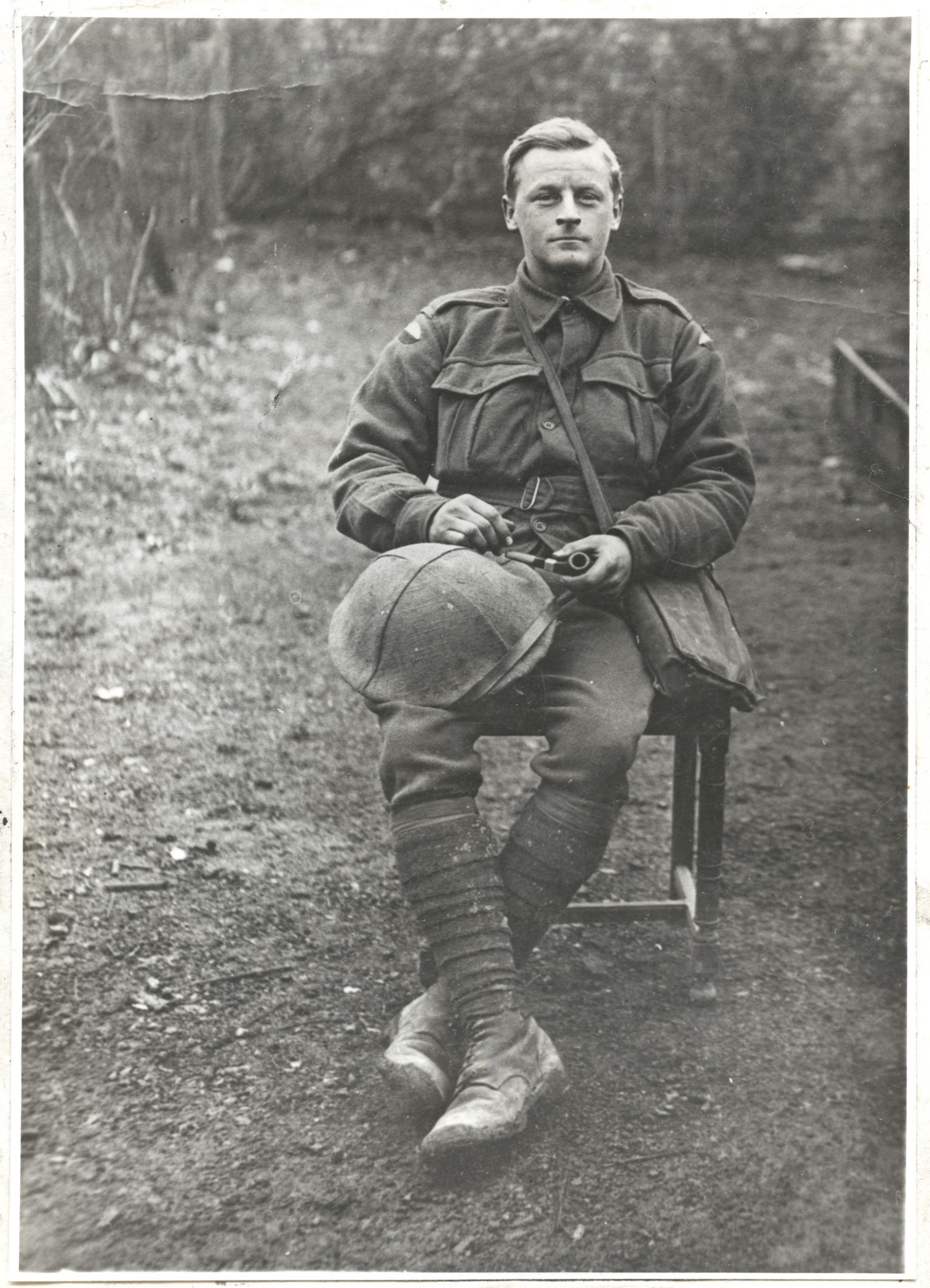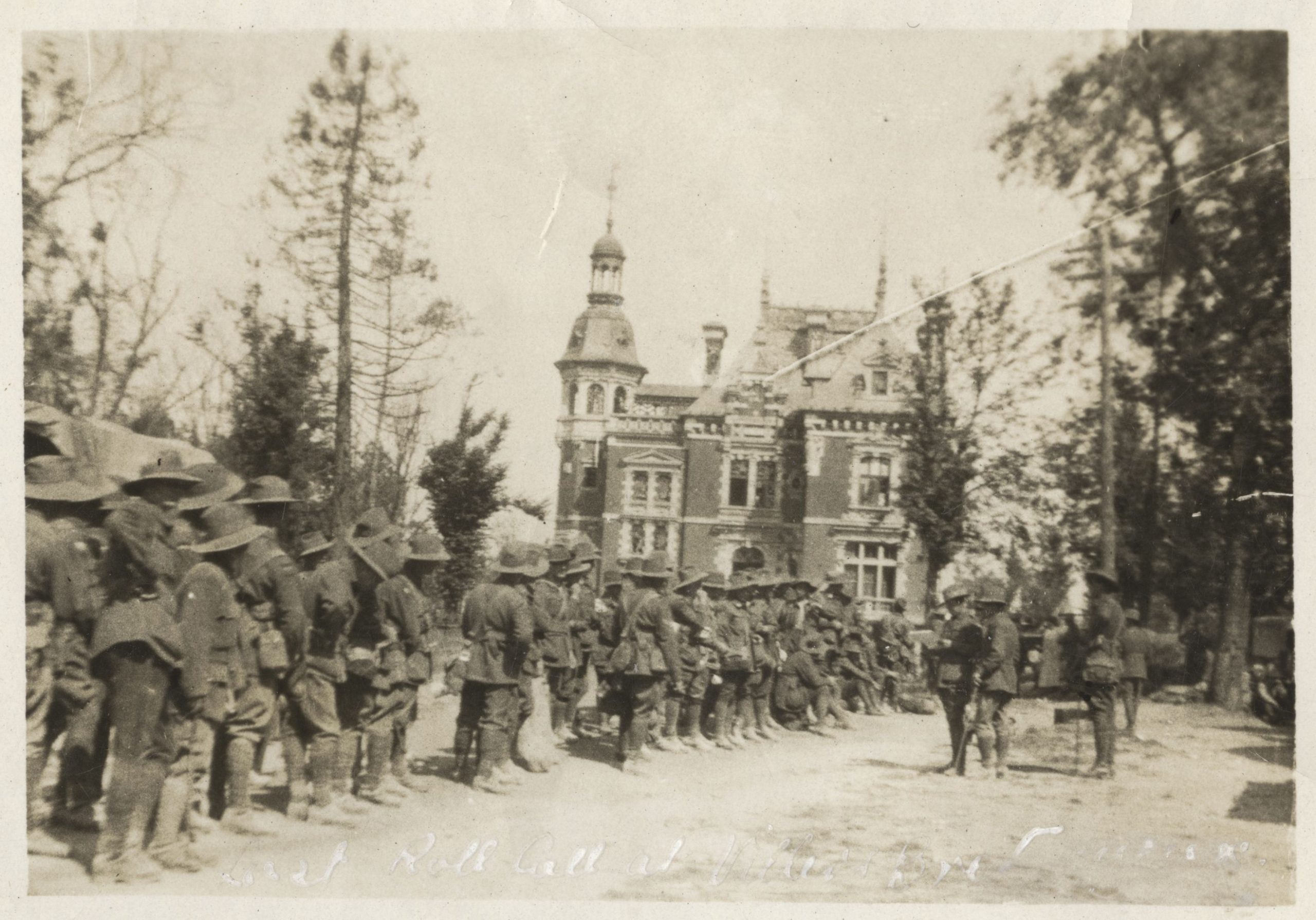Tasmanians in World War 1: Private Reginald Allan Biggs (Private Ashmead)

Reginald Allan Biggs was a journalist, musician and soldier. His journal of his time as a signaller in the First World War is a fascinating insight into his experiences in the war.
Soldier and journalist
Reginald was the sixth of ten children born to Albert Walter and Ada Emma Biggs in Launceston on 17 April 1897. He attended Lea Hurs’ School in Scottsdale run by Mrs Dolly Cottman. Reginald received a prize for his patriotic essay on Empire Day, May 1908, before 150 scholars at the Scottsdale celebrations. In 1909, he won the John Cameron scholarship of £12 12s yearly. It was open to boys under thirteen and given each year to the boy who at the intermediate examination came nearest to gaining a bursary without securing one. As a result, Reginald went to Launceston Church Grammar School for three years. In Launceston, November 1909, Reginald passed the Grade 5 examination in piano conducted by the Universities of Melbourne and Adelaide.

After matriculation, Reginald worked for fifteen months as an office boy for a shipping company before starting as a cadet journalist with the Launceston Examiner. At the outbreak of the war, he was a member of the 92nd Infantry (Launceston), Australian Military Forces; a citizen military force. He was living in Scottsdale when, on 27 February 1916 at the age of eighteen, he joined the AIF with the rank of Private. His older brother, Leonard, a postal assistant and comrade in the 92nd, had joined only two days earlier. Both men were to survive the conflict.
Reginald arrived at Claremont camp for basic training on 1 March 1916. He had volunteered for overseas war service agog with enthusiasm and patriotic fervour. Rejected many times because of his short stature (156cm) and false teeth, he finally gained admission. His experience with the home militia saw him assigned to the signallers. Surviving an epidemic of deadly meningitis that swept the camp, he became part of the newly formed Tasmanian 40th Battalion. Originally planned as two companies each from Tasmania and Victoria, it became a solely Tasmanian battalion in the belief it would be good for public relations. It proved sound advice. Lieutenant General Sir John Monash wrote…
“The fact that it was composed wholly of the men of a small island state, gave it a special stimulus to the highest emulation of all other units. In no other unit was the pride of origin and sense of responsibility to the people it represented stronger than in the 40th.”
Reginald proved himself the best signaller of all and won a place in the Headquarters signalling section. In April 1916, Reginald arrived in Broadmeadows Camp on the outskirts of Melbourne to undertake extra training. He turned nineteen while there. After final training at Claremont, the brothers embarked on the Berrima (Australian Troopship No.35) in Hobart on 1 July 1916. The Examiner published Reginald’s routine aboard the transport under the heading “With the Fortieth” on 19 September 1916.
“Signaller Reginald Biggs, of the ‘Examiner’ staff kept a diary of the voyage on the troopship on which the 40th Battalion went to England. Largely it is a record of the small daily incidents that mark such a voyage, but there are some items of interest. For instance, no time was lost in forming a Y.M.C.A. branch. This was done when two days’ out. Boxing bouts are made possible by supplies of gloves from the Tasmanian Battalion comforts fund. So were many luxuries at the table. Divine service was assisted by the formation of a choir. The monotony of the trip was relieved by such things as physical, boat, fire, and signalling drill, and by a special inspection of kits. Then there was pay day! The transport encountered some heavy weather, and one day a man attached to the transport section who had ventured on to the forecastle head was swept off his feet by a tremendous wave, and sent to hospital with a broken knee.”
Reginald’s diary, That Other War, documents his wartime experiences. As a signaller, he had to maintain communications between Battalion and Company headquarters, and the Company’s frontline office by field telephone. Because of his civilian occupation, he became known as Private Ashmead, after the British wartime correspondent, Ellis Ashmead-Bartlett.
“My penname … was the nickname dubbed on me by my tent mates when I entered camp on enlistment. On learning that the occupation which I had left behind was a cadet journalist, they at once thought of the war correspondent Ashmead-Bartlett who had brought world-fame to the ANZACS for their heroic valour in the campaign on the Turkish Peninsula, Gallipoli.”
Reginald saw action in France and Belgium. Although not a frontline infantryman, his duties often took him to within 100 metres of the German defences. Usually, Reginald served in company headquarters; the support trenches 100 metres behind the frontline; and repairing broken telephone lines in open country. Even so, support troops came under fire from German guns and poison gas, causing casualties. Reginald could find himself in the heat of the battle…
“I found that the gun was trained right on me. I flattened out and tried to simulate “dead”. It was clear that the gun was aimed at me as I lay there… for his bullets were landing just near my head and kicking up pebbles which hit my face. I thought, “he can’t miss me now; it will get me right though the crown of my head!” The streams of bullets stopped. Praying that the gunner was reloading a full belt into his gun, I slithered forward flatter than any snake until I felt the ground dip sharply and slid headfirst into a shell hole. I was trembling uncontrollably and panting with terror.”
Reginald was at Armentieres, the town renowned for the song about its famous Mademoiselle.
“Every man in the 40th who went through the early stages of the Battalion’s campaign in Belgium and France will feel his pulse quicken at the mention of Armentieres. That was where we began to know “la belle France”, underwent our baptism of fire, spent months of toil, danger and misery in the trench system east of it, and enjoyed our leisure during the breaks when we had been relieved from trench life… With the passing of time we all came to regard Armentieres as “our town.”

The place made such an impression that years later he wrote Armentieres and its ‘Mademoiselles‘ detailing its history and his wartime experiences there.
Reginald left the AIF on 3 November 1919 receiving the British War Medal and Victory Medal. Reginald’s service dossier, digitised by the National Archives of Australia, is available online. One image of interest (#22) records that while in Launceston, on 20 May 1916, Reginald was charged with refusing to obey a lawful order by a non-commissioned officer. He was fined thirty shillings and confined to barracks for a week with loss of pay of one pound, ten shillings. This resulted from a long-running antagonism between the Company’s Corporal and the rest of the men, of whom Reginald became spokesman. In truth, it was a trifling matter, especially compared with the horrors to come. The Corporal who brought the charge against him felt guilty afterward and refunded Reginald the thirty shillings out of his own pocket. The background to the incident makes for interesting reading early in his diary. Apart from this minor offence, Reginald’s service remained incident-free. Although, his criticism of the harsh discipline of those in command is a constant theme throughout his account…
“This cruel scourge chafed me constantly. I formed the view that it had originated with the army hierarchy, who had seen to it that they and the “officer class” would never be its victims. Its doctrines were preached from the unholy writ of King’s Rules and Regulations and percolated down through the lesser and still lesser “gods” of commissioned rank to be inflicted upon the common soldiers.”
Rightly or wrongly, Reginald would no doubt agree with the expression made famous by Alan Clark that it was a war “fought by lions and led by donkeys”. With the coming of peace Reginald remarked; what a joy it was: but the greatest boon of all was the freedom from military discipline!
After the war, Reginald toured Canada and America, a trip documented in his book, “See America, Young Man”. Eventually, he made his way back to Tasmania meeting family and friends at Launceston before returning home to Scottsdale.
On 5 November 1921, Reginald married Edith Mary Soans at St Johns Church, Launceston. The couple settled at Hobart Road in Launceston. Reginald continued his interest in music. At the 1927 Easter competition at the Albert Hall in Launceston, he won the Open Section (Own Selection) with his cello solo, Berceuse de Jocelyn by Benjamin Godard. He received the award Grand Champion Solo Gentleman. The only mark against his name came in April 1932 when fined ten shillings for a parking offence. After the horrors of the frontline this surely had little impact on Reginald.
After the war, Reginald resumed his career with the Examiner. He spent nine years with the Company before he and Edith moved to South Perth W.A. to further his career and start a family. Leonard, who had served with Reginald in the 40th, moved to Nedlands, about 10kms from his brother.
In January 1937, Reginald, Edith and their two children returned to Scottsdale for a family reunion, with Leonard. No family member had died of the ravages of war or time, which led to a rare happy ending to the conflict.
The diary is the account of a humble infantry private whose service was often in the thick of the horrors, bloodshed, danger and hardships. Sources used to write the diary are…
- The letters Reginald sent home from the front
- Diaries he had kept in shorthand even while under fire
- Clippings of all his articles published by the Examiner
- Detailed memories provided by his prodigious recall
- Material that he did not witness himself came from contemporaries
The diary of Private Ashmead is an exhaustive account of one man’s view of the war.

